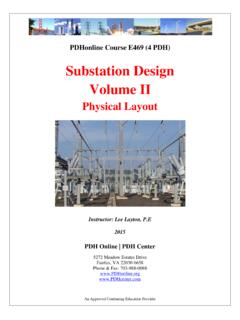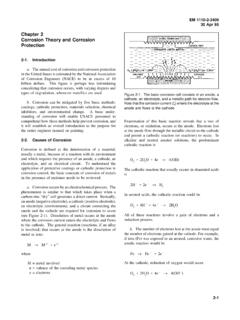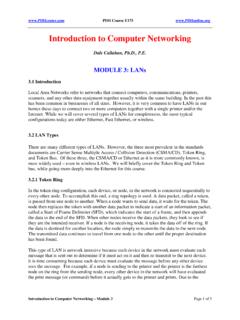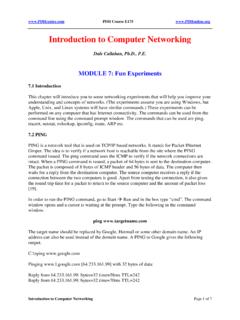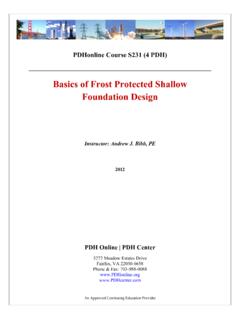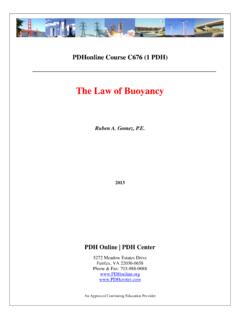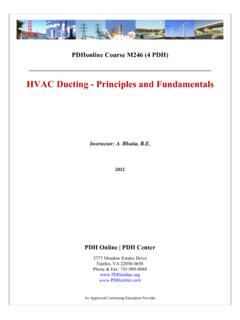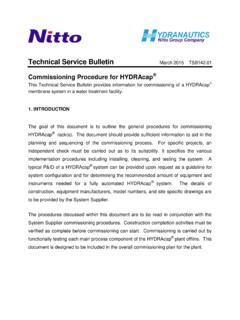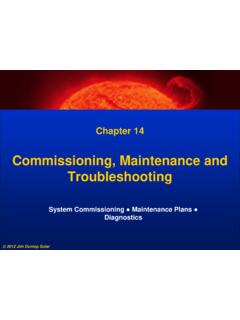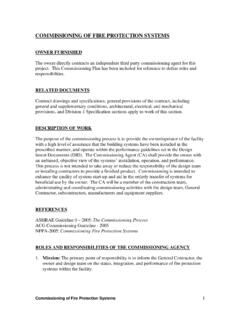Transcription of Commissioning Mechanical Systems - PDHonline.com
1 PDHonline Course M353 (6 PDH) Commissioning Mechanical Systems2012 Instructor: George E. Thomas, PEPDH Online | PDH Center5272 Meadow Estates DriveFairfax, VA 22030-6658 Phone & Fax: Approved Continuing Education PDH Course M353 George E. Thomas Page 2 of 75 Commissioning Mechanical system (s) George E. Thomas, PE CHAPTER 1 INTRODUCTION 1-1. Purpose This course provides information on the minimum requirements for Commissioning Mechanical Systems supporting major fixed Mechanical equipment. The purpose of this course is to provide engineers, facility managers, and others the information necessary to plan for and implement Commissioning of Mechanical Systems . The Commissioning process (often referred to as acceptance testing ) includes achieving, verifying, testing , accepting, and documenting that the performance of Mechanical Systems meets design intent and the owner and occupant needs.
2 Ideally, the process begins at the program phase and lasts at least one year after project-closeout. The Commissioning process involves the participation of all parties in the building delivery cycle, including, but not limited to representatives of the owner, designer and appropriate contractors. At project closeout, Systems needed for immediate operation of the facility have been tested and are considered acceptable. Upon achieving final acceptance at the conclusion of the post acceptance period, the last step of the Commissioning process, the owner and/or his operating and maintenance (O & M) contractor take over full ownership and responsibility of the Mechanical Systems . 1-2. Scope This course material can be used in the process of Commissioning Mechanical Systems in facilities. The Commissioning process applies to all phases of a facility s life-cycle including program, design, construction, acceptance, post-acceptance phases and training of O & M staff, and can be applied throughout the life of the building.
3 This course applies to assessment/ testing of new construction ( , Commissioning ), reassessment/retesting of existing facilities, or facilities modified or fitted with new equipment ( , re- Commissioning ), and also to assessment/ testing of operating facilities which were not commissioned when new ( , retro- Commissioning ). The requirements of this course are predominantly for testing Systems . It is assumed that detailed/comprehensive individual testing of equipment has been completed. 1-3. Objectives This course objective is to provide information on standardized Commissioning and re- Commissioning of Mechanical Systems in support of fixed Mechanical equipment in facilities. 1-4. General system testing requirements The purpose of Mechanical Systems Commissioning is to increase the reliability of Mechanical Systems after installation by identifying problems and providing a set of baseline values for comparison with subsequent routine tests. A procedure should be developed to include a planned approach (road map) of what should be done in order to verify the proper system installation.
4 This procedure is the Commissioning plan. Specific areas addressed in a Commissioning plan include the verification of the installation of all equipment/components, interface connections between equipment and individual Systems , and interconnection drawings. The development of this plan specific to each system and/or component is key to the usefulness of any maintenance program. The plan consists of the schedule of when acceptance and routine tests should be performed, test forms to be used to record the outcome of the tests which are retained for comparison with previous and subsequent tests, and a listing of the required test devices. Since the results of the Commissioning tests become baseline test values to compare with later tests and the results of the routine maintenance tests are PDH Course M353 George E. Thomas Page 3 of 75 compiled to identify any downward trend in performance, it is vital to the maintenance program to have accurate and complete records.
5 To perform the testing , the plan lists all required tests in order of performance and gives a schedule for each test. The work items and schedule depend on many issues including the importance and cost of the equipment, consequences of failure, age of equipment, past and future frequency of service, hours of operation, future maintenance availability, environmental conditions, and safety requirements. 1-5. Component testing The reliability of any system is dependent on the interconnection of the equipment and the equipment itself. This course s content is predominately for testing of Mechanical Systems themselves. It is assumed that the detailed and comprehensive individual testing of equipment has been completed before the commencing of Commissioning of the system . However, general testing procedures for the components of the Systems described in this course are addressed in chapter 3. Commissioning requirements for the system components must be provided with the original proposal for the procurement of the equipment.
6 The requirements provided by the equipment manufacturer should be adhered to in addition to the recommended testing herein. Although there are many different components to any Mechanical system , there are some tests that are common among the equipment. Examples of the common testing procedures include the assembly check, alignment check, grounding verification, insulation resistance tests and polarization index to name a few. These common tests are described in detail later in this course. Sufficient time should be allocated to define the inspections required, perform the check, and document the results. A review of the system drawings will show major pieces of equipment. Specific procedures should be developed for each test referencing the equipment to be used, drawings to be followed, and step by step procedures with readings to be recorded and forms for the results. 1-6. system Commissioning testing Mechanical Systems Commissioning on new projects is critical to insure that a system is installed properly, is operating properly and efficiently, and that it will remain in service for its projected life cycle.
7 The Commissioning of a system encompasses the individual testing of the related components, the verification of the component interconnection against the drawings, and the functional testing of the system as a whole. An understanding of the equipment involved and the modes of operation for a system are essential to the development of the system Commissioning plan. A survey of the equipment of the system and listing the equipment in order of importance and startup is the first step in developing the Commissioning plan. The schedule of the tests and inspections is dependent on many aspects of the equipment such as its importance and cost, the frequency of service, hours of operation, environmental conditions, accessibility, and safety requirements. The inspection, testing , and startup plan is then developed in conjunction with this schedule with instructions and procedures for the test plan. Examples of Systems testing are discussed in chapter 4 through 10. Checklists provided in this course assist in these inspections and tests.
8 They are found as reproducible forms at the end of this course. Problems may arise during the testing of the equipment and Systems . In order to identify and correct these problems, troubleshooting techniques should be developed. Checking of equipment such as fuses, lights, and breakers for continuity, equipment calibration and settings, and investigating for faulty equipment or connections should be the first troubleshooting steps. Examples of the possible causes to common problems are shown for each system in the chapters that follow. 1-8. Cost of Commissioning The cost of Commissioning for a Mechanical system is dependent upon many factors including the system size, complexity and the level of reliability desired. New building construction, renovation of an existing building, or the modernization also will affect the cost of Commissioning . Experience has shown that the initial Commissioning cost is more than offset by increased system reliability and reduced operating costs.
9 The cost for Commissioning a new building can range from to percent of the total construction cost (shown in the table below). For an existing building the Commissioning costs can range from 3 to 5 percent of the total PDH Course M353 George E. Thomas Page 4 of 75 operating costs. Commissioning costs and savings are further discussed in chapter 2. Table 1-1 Costs of Commissioning , new construction Commissioning Scope Cost Entire building(HVAC, Controls, Electrical, of total construction cost Mechanical ) Commissioning Entire building(HVAC, Controls, Electrical, of total construction cost Mechanical ) Commissioning HVAC and Automated Control system Commissioning of Mechanical system cost Electrical Systems Commissioning of electrical system cost Energy Efficiency Measures Commissioning $ per square foot CHAPTER 2 THE NEED FOR Commissioning 2-1.
10 General background Due to competitive pressures, facility owners look for low cost and abbreviated schedules to bring a facility from concept to operation. These competitive driving forces are reflected in the facility designers and contractors prices. To be price competitive, Commissioning is often given cursory attention or not included altogether. While owners may be hesitant to delay facility opening, the cost and time invested in proper Commissioning produce returns in a number of avenues including cost and energy savings, quality of system operation and more accurate realization of the goals of the project. a. Complex building Systems . Building Systems continue to become more complex. Because of this complexity, an ever increasing emphasis must be placed on design, installation and operation error evasion. A Commissioning effort will reduce these errors. When Systems do not operate correctly, the cost of operation and maintenance increases. The savings which were supposed to be achieved because of the high technical nature of the new equipment and building system components is never realized.
